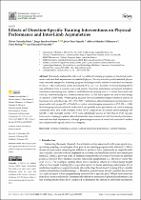Please use this identifier to cite or link to this item:
https://repositorio.usj.es/handle/123456789/774
| Title: | Effects of Direction-Specific Training Interventions on Physical Performance and Inter-Limb Asymmetries |
| Authors: | Gonzalo-Skok, Óliver


Sánchez-Sabaté, Jorge 

Tous-Fajardo, Julio 
Mendez-Villanueva, Alberto 
Bishop, Chris John 

Piedrafita, Eduardo 
|
| Keywords: | Resistance; Trainingeccentric; Overloadfunctional; Performancevariable training |
| Issue Date: | 18-Jan-2022 |
| Publisher: | MDPIST ALBAN-ANLAGE 66, CH-4052 BASEL, SWITZERLAND |
| Citation: | Gonzalo-Skok, O.; Sánchez-Sabaté, J.; Tous-Fajardo, J.; Mendez-Villanueva, A.; Bishop, C.; Piedrafita, E. Effects of Direction-Specific Training Interventions on Physical Performance and Inter-Limb Asymmetries. Int. J. Environ. Res. Public Health 2022, 19, 1029. https:// doi.org/10.3390/ijerph19031029 |
| Abstract: | This study analyzed the effects of two different training programs on functional performance and inter-limb asymmetries in basketball players. Twenty-four elite youth basketball players were randomly assigned to a training program including variable unilateral horizontal movements (VUH, n = 12) or unilateral lateral movements (VUL, n = 12). Eccentric-overload training (EOT) was performed twice a week for a six-week period. Functional performance assessment included a countermovement jump test, unilateral multidirectional jumping tests (i.e., lateral, horizontal, and vertical), a rebound jump test, a limb symmetry index, a 25 m linear sprint test, and several change of direction (COD) tests. Within-group analysis showed substantial improvements in almost all functional tests in both groups (ES = 0.35-0.89). Furthermore, almost all jumping asymmetries were improved in both groups (ES = 0.38-0.69) except for vertical jumping asymmetry in VUL (ES = -0.04). Between-group analyses showed a substantial and possibly better performance in vertical jumping asymmetry and 5 m in VUH compared to that of VUL, respectively. In contrast, lateral jumping with left (ES = 1.22) and right leg (ES = 0.49) were substantially greater in VUL than in VUH. Specific force-vector training programs induced substantial improvements in both functional performance tests and inter-limb asymmetries, although greater improvements of lateral and horizontal variables may depend on the specific force vector targeted. |
| URI: | https://repositorio.usj.es/handle/123456789/774 |
| ISSN: | 1660-4601 |
| Appears in Collections: | Artículos de revistas |
Files in This Item:
| File | Description | Size | Format | |
|---|---|---|---|---|
| Effects of Direction-Specific Training Interventions.pdf | 1,19 MB | Adobe PDF |  View/Open |
This item is licensed under a Creative Commons License

